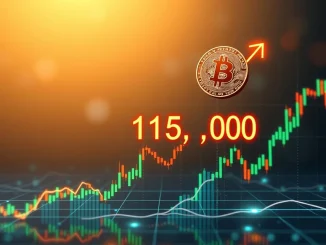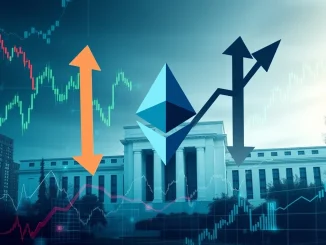
Is Bitcoin losing its shine as a safe haven asset? Despite growing anxieties about stagflation fueled by former President Trump’s tariff policies, Bitcoin (BTC) is currently underperforming. While traditional safe havens like gold are soaring, and even the stock market is showing more resilience, Bitcoin is struggling. This raises critical questions about Bitcoin’s role in the current economic climate and its future potential. Let’s dive into the urgent market dynamics and explore what this means for crypto investors.
Decoding Bitcoin’s Struggle Amid Stagflation Fears
The global economy is facing a complex challenge: stagflation. This term, a blend of stagnation and inflation, describes a situation where economic growth slows down while prices continue to rise. Recent reports highlight that fears of stagflation are intensifying, partly due to the potential impact of Trump’s tariff policies. Historically, Bitcoin has been touted as a safe haven asset, a refuge for investors during times of economic turmoil. However, the current market narrative presents a different picture. CoinDesk reported that Bitcoin has declined by 10% this year, starkly contrasting with gold’s impressive 13% surge and even the S&P 500’s relatively smaller 4% dip. This divergence prompts us to question: why isn’t Bitcoin acting as a safe haven now?
Why Isn’t Bitcoin Behaving Like a Safe Haven?
Several factors could be contributing to Bitcoin’s unexpected performance during these stagflation fears. Analyst Noelle Acheson offers a crucial perspective: while Bitcoin retains its long-term safe haven appeal, short-term market uncertainty is currently overshadowing this narrative. This uncertainty could stem from various sources, including:
- Macroeconomic Headwinds: Stagflation itself creates a climate of uncertainty. Investors might be hesitant to allocate heavily to volatile assets like Bitcoin when the broader economic outlook is unclear.
- Interest Rate Sensitivity: Bitcoin, like other risk assets, can be sensitive to interest rate changes. Expectations around Federal Reserve policy and potential rate hikes can influence investor sentiment and capital flows.
- Market Maturity: While Bitcoin is maturing, it’s still a relatively young asset class compared to gold or established equities. Its safe haven narrative might still be developing and not fully ingrained in investor behavior during all types of economic stress.
- Regulatory Landscape: Ongoing regulatory discussions and potential policy changes in various jurisdictions can introduce volatility and uncertainty into the crypto market.
In essence, while the fundamental thesis of Bitcoin as a decentralized, inflation-resistant asset remains, current market dynamics and investor perceptions are creating headwinds.
Trump’s Tariffs and the Stagflation Equation: A Closer Look
Former U.S. President Trump’s tariff policies are playing a significant role in the current stagflation concerns. Tariffs, essentially taxes on imported goods, can lead to:
- Increased Input Costs: Businesses relying on imported materials face higher costs, which can be passed on to consumers in the form of higher prices, fueling inflation.
- Trade Wars and Uncertainty: Tariffs can escalate into trade disputes, creating uncertainty for businesses and disrupting global supply chains. This uncertainty can dampen economic growth.
- Reduced Consumer Spending: Higher prices due to tariffs can erode consumer purchasing power, potentially leading to decreased demand and slower economic activity.
Markus Thielen, founder of 10x Research, provides an insightful perspective on this. He suggests that the market might be mispricing the stagflation risk and that recent market movements are largely attributable to the front-loaded impact of these tariffs. This implies that the initial shock of tariff implementation might be already priced in, and the market could be anticipating future developments.
The Potential for a Crypto Rebound: Watching the Fed
Despite the current struggles, there’s a glimmer of hope for a potential crypto rebound. Markus Thielen points to a crucial catalyst: the U.S. Federal Reserve’s stance on monetary policy. If the Fed signals a dovish stance, indicating a willingness to ease monetary policy or slow down interest rate hikes, it could be a significant positive trigger for Bitcoin and the broader crypto market.
A dovish Fed stance could signal:
- Easing Inflationary Pressures: A perception that the Fed is managing inflation effectively could reduce stagflation fears and improve overall market sentiment.
- Increased Liquidity: Easier monetary policy can inject more liquidity into the financial system, potentially flowing into risk assets like Bitcoin.
- Weakening Dollar: A dovish Fed stance can sometimes lead to a weaker US dollar, which historically has been correlated with increased demand for Bitcoin as an alternative store of value.
Therefore, closely monitoring the Federal Reserve’s communications and policy decisions will be crucial in gauging the potential for a crypto rebound in the near future.
Navigating Market Uncertainty: Actionable Insights for Crypto Investors
In this environment of market uncertainty and stagflation fears, what should crypto investors do? Here are some actionable insights:
- Stay Informed: Keep abreast of macroeconomic developments, particularly inflation data, tariff policies, and Federal Reserve announcements.
- Diversify: Don’t put all your eggs in one basket. Diversify your portfolio across different asset classes, including but not limited to cryptocurrencies, gold, and equities.
- Manage Risk: Understand your risk tolerance and adjust your portfolio accordingly. Volatility is inherent in the crypto market, especially during times of economic uncertainty.
- Long-Term Perspective: Remember Bitcoin’s long-term potential as a decentralized, inflation-resistant asset. Short-term price fluctuations are normal, but the fundamental value proposition remains.
- Consider Dollar-Cost Averaging (DCA): Instead of trying to time the market, consider DCA, which involves investing a fixed amount of money at regular intervals. This can help mitigate the impact of volatility.
Conclusion: Bitcoin’s Future Hinges on Economic Clarity
Bitcoin’s current struggle amidst stagflation fears and tariff uncertainties is a complex situation. While it’s not behaving as a traditional safe haven in the short term, the long-term narrative remains intact. The market is grappling with multiple factors, including macroeconomic headwinds, tariff impacts, and anticipation of Federal Reserve policy. The potential for a crypto rebound is real, particularly if the Fed signals a dovish stance. For crypto investors, navigating this period requires staying informed, managing risk wisely, and maintaining a long-term perspective. The coming months will be critical in determining whether Bitcoin can regain its footing as a leading safe haven asset in the face of ongoing economic challenges. The urgent need for clarity in economic policy and market direction will ultimately dictate Bitcoin’s trajectory.



